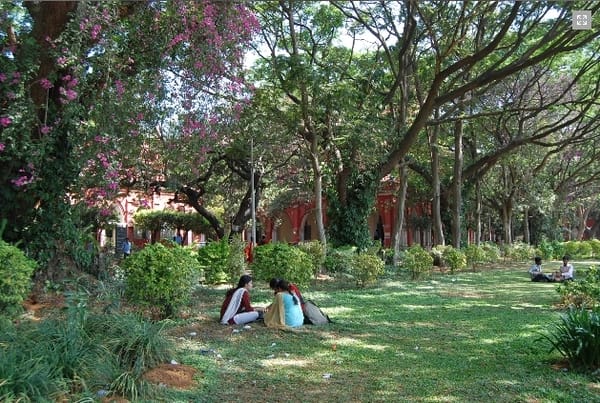On October 13th, a National Law School of India University (NLSIU) student was gang raped in the adjoining Bangalore University campus near Nagarbhavi.
By now we all know enough details about the student to construct an image of who she might be. Her age, her boyfriend’s name, age, his job profile, that he owned a car, where they both are from, insinuations towards their intimacy levels, whether she got into trouble with hostel authorities earlier for ‘this’ kind of behaviour. All this information was culled out in the name of journalism and served as news reports.
By now it is almost rhetorical to ask whether media houses should be reporting such details of a sexual assault victim.

Students of NLSIU, staging a protest in front of Town Hall, Bangalore on Oct 22. Pic: N Jayaram
Largely the reports were based on anonymous sources within the police force and the hospital where the student was taken for medical examinations.
There was also debate on whether or not she was actually raped. Debates were not open or loud but the subtler kind that is harder to spot, but it was there nevertheless. The rape was questioned by quoting sources (again, anonymous in most reports) who said that the student did not have any ‘visible injuries.’
The rape was also questioned when a police personnel (again, anonymous) wondered why one of the gang members returned to the crime spot when it is common sense to stay away from it.
All these speculations / guesses by anonymous sources made its way into big bold headlines. It is not hard to imagine the conclusions that an average reader might have drawn from these.
There was another interesting side debate that this incident triggered off. And that was of the ‘liberal’ attitude of NLSIU authorities and campus itself. Bangalore University (BU) Registrar B C Mylarappa was quoted "if they (NLSIU authorities) do not correct themselves or continue to fail to keep their students under control, we will consider withdrawing our land provided to NLSIU." (DNA, 16 Oct). Mylarappa went on to say that BU hostels were shut by 7pm, implying that hence their students were ‘safe.’

Students at the wooded area around Bangalore University. Pic courtesy: BU website
Mylarappa did not say a word about why a campus full of young students was not guarded. He did not explain why he thought prudent to lock up students (both men and women) when the criminals were free to carry on with their activities on the very BU grounds, after dark?
Five days after the BU incident, on October 18th, three bar girls were kidnapped from their house, gang raped and later let off.
The media reports again speculated on whether the three women were indeed raped, by quoting the other women who were in the house when the three women were kidnapped. A little detail as to the women who were left behind will have no way of knowing what happened to the kidnapped women, seems to have not registered with the reporters. Even in this case short of knowing their door number, the reports revealed enough details about who the women were.
Both these instances were criminal cases of sexual assault on women. Yet, there were less ‘follow up’ reports in the case of bar girls compared to the NLSIU student’s case. Speculations were not so high in this case either. What made one case more newsworthy, or to put it crassly more juicy, than the other?
Yes, in both the cases the criminals were identified and arrested. Something that did not happen even five years ago. But why is the onus on the victims to prove that they were indeed victims? And why the double whammy of being practically identified as victims?
What’s missing?
One of the regional newspaper even ran a piece, advising women on how to to remain safe and avoid being raped. First advice was – stay home after sundown.
If anything, the two cases prove that women are safe neither in their own homes nor out in the open.
There was no advisory issued to men as to why it is important for them to refrain from assaulting women or even how to help them if the men happened to witness one such incident.
Shouldn’t the larger debate be about women’s place in the society? On how crimes against women is perceived? On what responsible journalism should be in a situation like this? On what kind support a victim of sexual crime (irrespective of gender or age) should be provided?⊕
Women advised to stay indoors after dark? It is the male population raping and assaulting women everyday. shouldn’t men be instructed to feel ashamed at the very thought of assaulting a woman and to behave in a dignified way rather than a lustful brash beast?!!
teach young boys in school to not think they have the right or power to demean a woman. one of them is a future rapist. try to Control the criminals not the victims!